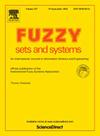Algebraic structure of the Gaussian-PDMF space and applications on fuzzy equations
IF 3.2
1区 数学
Q2 COMPUTER SCIENCE, THEORY & METHODS
引用次数: 0
Abstract
In this paper, we extend the research presented in [26] by establishing the algebraic structure of the Gaussian Probability Density Membership Function (Gaussian-PDMF) space. We provide the explicit form of the membership function. Under the assumptions that all membership functions belongs to Gaussian-PDMF space, each fuzzy number can be uniquely identified by a vector. We introduce five operators: addition, subtraction, multiplication, scalar multiplication, and division. We demonstrate that, based on our definitions, the Gaussian-PDMF space exhibits a well-defined algebraic structure. For instance, it is a vector space over real numbers, featuring a subset that forms a division ring, allowing for the representation of fuzzy polynomials, among other properties. We provide several examples to illustrate our theoretical results.
高斯- pdmf空间的代数结构及其在模糊方程上的应用
本文通过建立高斯概率密度成员函数(Gaussian-PDMF)空间的代数结构,对 [26] 中的研究进行了扩展。我们提供了成员函数的显式形式。在所有成员函数都属于高斯-PDMF 空间的假设下,每个模糊数都可以用一个向量来唯一标识。我们引入了五个运算符:加法、减法、乘法、标量乘法和除法。我们证明,基于我们的定义,高斯-PDMF 空间呈现出定义明确的代数结构。例如,它是一个实数向量空间,具有一个形成除法环的子集,可以表示模糊多项式等性质。我们提供了几个例子来说明我们的理论结果。
本文章由计算机程序翻译,如有差异,请以英文原文为准。
求助全文
约1分钟内获得全文
求助全文
来源期刊

Fuzzy Sets and Systems
数学-计算机:理论方法
CiteScore
6.50
自引率
17.90%
发文量
321
审稿时长
6.1 months
期刊介绍:
Since its launching in 1978, the journal Fuzzy Sets and Systems has been devoted to the international advancement of the theory and application of fuzzy sets and systems. The theory of fuzzy sets now encompasses a well organized corpus of basic notions including (and not restricted to) aggregation operations, a generalized theory of relations, specific measures of information content, a calculus of fuzzy numbers. Fuzzy sets are also the cornerstone of a non-additive uncertainty theory, namely possibility theory, and of a versatile tool for both linguistic and numerical modeling: fuzzy rule-based systems. Numerous works now combine fuzzy concepts with other scientific disciplines as well as modern technologies.
In mathematics fuzzy sets have triggered new research topics in connection with category theory, topology, algebra, analysis. Fuzzy sets are also part of a recent trend in the study of generalized measures and integrals, and are combined with statistical methods. Furthermore, fuzzy sets have strong logical underpinnings in the tradition of many-valued logics.
 求助内容:
求助内容: 应助结果提醒方式:
应助结果提醒方式:


